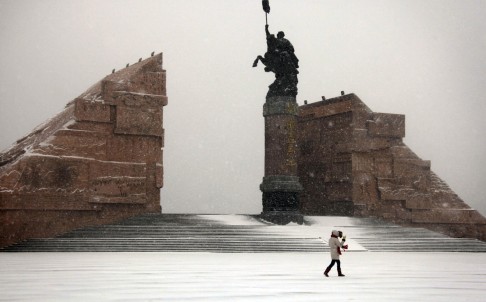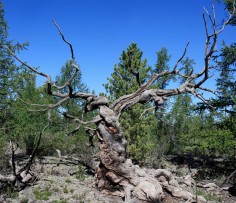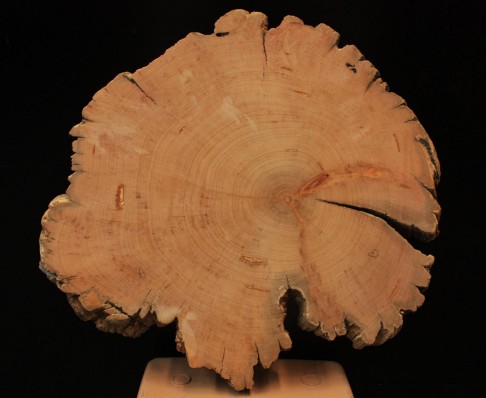Period of warmth and rain, revealed in the rings of centuries-old pines, carpeted Central Asia's steppes with grass for conqueror's horses
Genghis Khan's mausoleum in Ejin Horo Banner, in Chna's Inner Mongolia region. His body has been lost. Photo: AP
Scientists have discovered an explanation for the phenomenal success of Genghis Khan in a most unlikely place - tree trunks.
Amy Hessl of West Virginia University and Neil Pederson of Columbia University in New York conducted a study on a stand of millennium-old Siberian pine trees growing in cracks on a lava flow in northern Mongolia.
Their team cut cross sections from the trunks of dead trees and took thin, chopstick-sized cores from living ones for comparison. The rings in the samples revealed a period of unusually warm and rainy weather between the years 1211 and 1225, coinciding precisely with the meteoric rise of Khan.
"Trees are wonderful natural archives of environmental history" Hessl told the Sunday Morning Post.
"The trees we studied can live for over a thousand years and they are extremely sensitive to changes in soil moisture. The changes create variability in the size of their annual rings and this tells us a lot about past climate conditions."
The mild temperatures and plentiful rain would have caused Central Asia's usually dry, rocky steppes to sprout a luxuriant carpet of grass. Hessl said this sudden profusion contributed to Khan's success.
"This high grassland productivity would have sustained huge herds of grazing livestock and allowed large numbers of people to gather in one place," she said. "We think that the wet climate and resulting grassland productivity is what allowed Genghis Khan to concentrate his forces in northern Mongolia and launch his military campaigns, ultimately creating his vast empire."
Khan wasn't born to greatness. His given name was Temujin and he was the son of a minor chieftain. At the time of his birth, around 1162, Mongolian society was split into a number of warring tribes and plagued by violence and social unrest.
When Temujin was only five years old his father was murdered by rivals. The boy, his mother and his siblings were expelled from their clan to fend for themselves. They lived in poverty, foraging for fruit and roots, fishing and hunting small game.
When he was 16, Temujin married a woman called Börte in a strategic move that cemented an alliance between his clan and hers. Having reclaimed his family's status, he set about unifying Mongolia's disparate tribes. This he achieved with a series of brilliant military campaigns and diplomatic manoeuvres. By 1206, Temujin had united his nation. He was duly proclaimed Genghis Khan, the "Universal Ruler".
Hessl believes the climate played a role in all of this. "During Genghis Khan's early years," she said, "the climatic conditions were extremely bad, especially during the 1180s when there was one of the most severe droughts of the last few thousand years. It is probably no coincidence that during that period there was internecine warfare and political disintegration among the Mongol tribes. Then around 1206 we see a major climate transition and the start of this unusually clement period. Having unified the tribes, Genghis Khan was able to take full advantage of the new conditions."
With the steppes swathed in grass, Khan amassed an army and set off on a whirlwind tour of victory and destruction. He and his warriors conquered a vast area that stretched across Asia from the Pacific Ocean to the Caspian Sea, taking in parts of northern India and the Middle East, and forming the largest contiguous land empire in history.
The key to the Mongols' military success was the horse, and more grass meant more horses.
The horses were a native breed of the steppes. Small, hardy and muscular, these steeds were fast and flexible in combat and gave the warriors a considerable advantage in warfare. Mongolian horses are sure-footed when crossing rugged terrain and have a unique gait that conserves energy, allowing them to travel long distances without tiring.
Khan's men were equestrians of unrivalled skill. They could shoot from the saddle at full gallop, keeping their aim true by releasing their arrows at the precise moment when all four feet of their horses were off the ground. They were trained to turn and fire their arrows backwards, or hanging from one side of the saddle using the horse, which wore its own armour, as a shield.
Khan's success as a leader came about thanks to a perfect combination of personality and circumstance. Temujin's brutal childhood experiences shaped the man he was to become, sharpening his survival instincts and fuelling his desire for power. "His leadership abilities were outstanding," said Hessl, "but what our work shows is that the climate was also an important factor".
Khan died in 1227 after falling from a horse, but his influence on the people of Asia didn't stop there. His soldiers, unsurprisingly, had children with the women of the lands they conquered.
Scientists have analysed the DNA of present-day Asians to determine the Mongol army's genetic footprint.
Garrett Hellenthal is the lead author of an important new study led by scientists from Oxford University and University College London. His team produced Globetrotter, an incredibly detailed map that plots the genetic histories of 95 populations across the world.
In the case of Khan, the map identified a clear genetic signal which tracks the boundary of the former Mongol empire.
"We can pinpoint a massive influx of Mongolian DNA to the precise time that Genghis Khan's army went on the rampage," Hellenthal said.
This article appeared in the South China Morning Post print edition as Genghis Khan's secret told by ancient trees



No comments:
Post a Comment